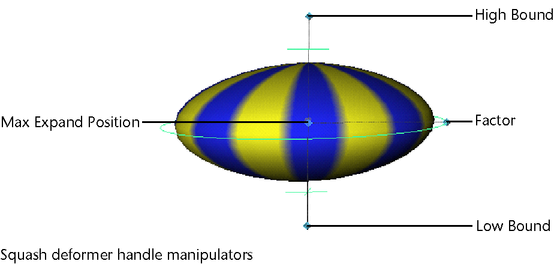After you create the squash deformer, its handle is displayed in your scene and its nodes are listed in the Channel Box. The nodes include the squash handle node (default name: squashnHandle), the squash handle shape node (squashnHandleShape), and the squash deformer node (default name: squashn).
You can edit the effects of the squash deformer by editing the squash handle node and the squash deformer node. You can move (translate), rotate, and scale the squash handle to edit the effects of the deformation. You can also edit the squash deformer node’s keyable attributes (channels), which are displayed in the Channel Box.
 You can also paint weights to adjust the effect of the deformer. See Paint nonlinear deformer weights.
You can also paint weights to adjust the effect of the deformer. See Paint nonlinear deformer weights.
To edit squash deformers using handle manipulators

The manipulators on the squash deformer handle let you edit attributes.
 -drag the mouse to edit interactively. Note that the Channel Box updates the values you are changing.
-drag the mouse to edit interactively. Note that the Channel Box updates the values you are changing.
To edit squash deformers by moving, rotating, or scaling handles
 (Linux and Windows) or
(Linux and Windows) or  (Mac OS X) key, moving the pivot point, and then pressing the
(Mac OS X) key, moving the pivot point, and then pressing the  or
or  key again.
key again.
Remember that you can access the deformer handle’s local axes (Display > Transform Display > Local Rotation Axes), rotate and scale pivots (Display > Transform Display > Rotate Pivots or Scale Pivots) and selection handle (Display > Transform Display > Selection Handle).
To edit squash deformers with the Channel Box
One quick way to select the squash deformer node is to select the object being deformed, and then select the squash deformer node in its history from the Channel Box (under INPUTS).
You can control which attributes are listed as keyable attributes (channels) in the Channel Box with the Channel Control editor (select Window > General Editors > Channel Control).
 -click and move the mouse to the left or right. By moving the mouse, you interactively change the value of the selected channel.
As you move the mouse, note that pressing the
-click and move the mouse to the left or right. By moving the mouse, you interactively change the value of the selected channel.
As you move the mouse, note that pressing the  key will give you finer control, and pressing the
key will give you finer control, and pressing the  key will give you less control.
key will give you less control.
 (Linux and Windows) or
(Linux and Windows) or  (Mac OS X) key.
(Mac OS X) key.
The squash deformer handle, squash deformer handle shape, and squash deformer nodes are all deleted. However, the object still has the tweak node as an input node, so any tweaks you might have made are preserved. Also, note that the various input nodes that structure the evaluation of the deformation are not deleted.
To edit squash deformers with the Attribute Editor
 +a.
+a.
See squash.